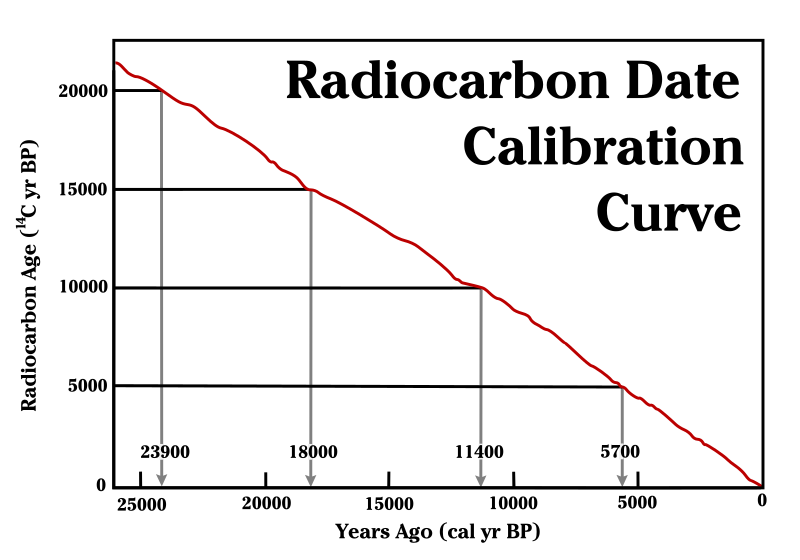
CALIB Radiocarbon Calibration M. Stuiver, P.J. Reimer, and R. Reimer Execute Version html Operating Instructions What's New. Any questions or comments regarding CALIB should be directed to Prof. Paula Reimer blogger.com@blogger.com Disclaimer (Please read!) Download: Downloadable versions of CALIB for MS Windows Radiocarbon dating of very young (less than ~ years) material is generally not reliable due high anthropogenic input of carbon to the atmosphere (e.g., see Levin and Hesshaimer, ), although Calibration curves are necessary for calculation of a calendar age due to fluctuations in atmospheric radiocarbon production and abundance over time. Though over the long term, pre-bomb atmospheric production balanced decay, short term perturbations in production and cycling interjected "wiggles" into the record of historical atmospheric and marine radiocarbon abundances
CalPal - Radiocarbon Calibration Online
This figure is directly based on the proportion of radiocarbon found in the sample. It is calculated on the assumption that the atmospheric radiocarbon concentration has always been the same as it was in and that the half-life of radiocarbon is years, radiocarbon dating calibration online. To give an example if a sample is found to have a radiocarbon concentration exactly half of that for material which was modern in the radiocarbon measurement would be reported as BP.
In order to see what a radiocarbon determination means in terms of a true age we need to know how the atmospheric concentration has changed with time, radiocarbon dating calibration online. Many types of tree reliably lay down one tree ring every year.
The wood in these rings once laid down remains unchanged during the life of the tree. This is very useful as a record of the radiocarbon concentration in the past. If we have a tree that is years old we can measure the radiocarbon in the rings and see what radiocarbon concentration corresponds to each calendar year.
Using very old trees such as the Bristlecone Pines in the western U. To extend this method further we must use the fact that tree ring widths vary from year to year with changing weather patterns. By using these widths, radiocarbon dating calibration online, it is possible to compare the tree rings in a dead tree to those in a tree that is still growing in the same region.
By using dead trees of different but overlapping ages, you can build up a library of tree rings of different calendar ages. This has now been done for Bristlecone Pines in the U. A and waterlogged Oaks in Ireland and Germany, and Kauri in New Zealand to provide records extending back over the last 14, years.
For older periods we are able to use other records of with idependent age control to tell us about how radiocarbon changed in the past. The information from measurements on tree rings and other samples of known age including speleothems, marine corals and samples from sedimentary records with independent dating are radiocarbon dating calibration online compiled into calibration curves by the IntCal group. These are the basis for the calibrations performed by the programs like CALIB and OxCal.
For more detail see the OxCal manual, radiocarbon dating calibration online. Calibration of radiocarbon determinations is in principle very simple. If you have a radiocarbon measurement on a sample, you can try to find a tree ring with the same proportion of radiocarbon. Since the calendar age of the tree rings is known, radiocarbon dating calibration online then tells you the age of your sample.
The pair of blue curves show the radiocarbon measurements on the tree rings plus and minus one standard deviation and the red curve on the left indicates the radiocarbon concentration in the sample, radiocarbon dating calibration online.
The grey histogram shows possible ages for the sample the higher the histogram the more likely that age is. The results of calibration are often given as an age range. This is not intended to be an exhaustive summary of radiocarbon calibration conventions but a brief guide, radiocarbon dating calibration online.
The first indicates the proportion of radiocarbon atoms in the sample as compared to samples modern in The second is directly derived from this on the assumption that the half-life of radiocarbon is years and the amount of radiocarbon in the atmosphere has been constant. Once calibrated a radiocarbon date should be expressed in terms of cal BC, cal AD or cal BP.
The cal prefix indicates that the dates are the result of radiocarbon calibration using tree ring data. These values should correspond exactly to normal historical years BC and AD. The term cal BP means the number of years before and can be directly compared to calendar years. This radiocarbon dating calibration online will tell you the years in which the radiocarbon concentration of tree rings is within two standard deviations of your measurement e.
This requires a computer since the calculations are more complicated. There are a number of calibration programs available including the radiocarbon dating calibration online program OxCal and CALIB, which runs on several platforms including an online version server at Belfast.
Carbon dating, the archaeological workhorse, is getting a major reboot
· Dating games. The basis of radiocarbon dating is simple: all living things absorb carbon from the atmosphere and food sources around them, including a certain amount of Author: Nicola Jones Calibration curves are necessary for calculation of a calendar age due to fluctuations in atmospheric radiocarbon production and abundance over time. Though over the long term, pre-bomb atmospheric production balanced decay, short term perturbations in production and cycling interjected "wiggles" into the record of historical atmospheric and marine radiocarbon abundances · This chapter discusses the role of 14 C dating in sea‐level research and includes a brief historical overview, an outline of the basic principles of 14 C dating, and a discussion of the differences between the radiometric approach and accelerator mass spectrometry (AMS).Cited by: 30
Keine Kommentare:
Kommentar veröffentlichen